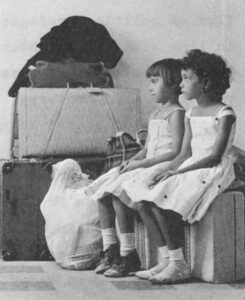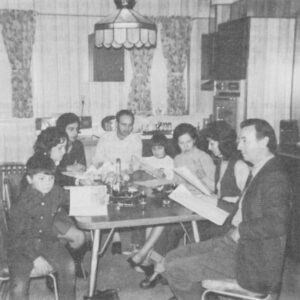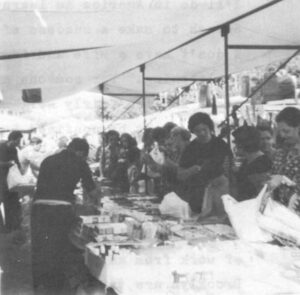At the beginning of 1974, I received an Alicia Patterson fellowship to study recent immigrants to the United States and their relationship to the rest of American society. At the time, there was little public awareness of the continuing importance of immigration in American life; when Americans thought about immigration at all, they usually regarded it as a historical phenomenon that ended several generations ago.
Within the space of a year, the anonymous immigrant has been transformed into a major object of news media concern: the “illegal alien,” The press still devotes scant attention to more than 400,000 immigrants who enter the United States legally each year, but the illegals are appearing in newspapers, magazines and television specials from coast to coast. There have been some outstanding exceptions, but most news coverage of illegal immigration has demonstrated the continuing inability and/or unwillingness of the American press to apply sophisticated investigative reporting techniques to complex social issues. If the news media had treated Watergate with the same naiveté as illegal immigration, Richard M. Nixon would still be in the White House.
A wave of illegal Aliens into the metropolitan region-officially estimated at more than one million — has overwhelmed the Federal Immigration and Naturalization Service here, virtually paralyzing the enforcement of immigration laws.
(The New York Times, 12/29/74)
On Jan. 9. Georgios and Athanasios Plessias were plying their trade, painting the Statue of Liberty at the union rate of $9.71 an hour, when they were arrested by federal officials. The Plessias brothers, laboring so diligently under the lamp beside the golden door, were illegal immigrants.
(The Washington Post, 2/2/75)
A swelling tide of illegal aliens coming into the United States is stirring alarm nationwide.
This year, says the Immigration and Naturalization Service, 2 to 2.5 million "illegals" will sneak into the country. More than half will go undetected.
Illegal aliens are already filling at least 1 million well-paying jobs at a time when unemployment is rising among U.S. citizens.
Some jobless aliens are turning to crime. Others are illegally siphoning off welfare money, medical aid and unemployment benefits.(U.S. News and World Report, 3/3/75)
While the tone varies from the sober cadence of the Times to the alarmist predictions of U.S. News, the message is clear: illegal aliens are entering the United States in huge and unprecedented numbers, and they pose a serious threat to the economic well-being of Americans. There are two reasons for the sudden discovery of the illegal alien by the news media. One, obviously, is the recession. Historically, the public and the press have taken a more benevolent attitude toward all types of immigration when the American economy depended on cheap labor for expansion.
 |
Reprinted by permission of the El Paso Journal. |
The second reason for the increased news coverage is an extraordinarily successful public relations campaign by Leonard F. Chapman Jr., the former Marine Corps commandant who is now the commissioner of the U.S. Immigration and Naturalization Service (INS). Chapman has succeeded in focusing the attention of the press on what is usually regarded as an “unsexy” news item by offering widely varying estimates of the number of illegal aliens and the jobs they are allegedly taking away from Americans. The figures have been spiced with highly unusual incidents like the apprehension of the two illegal immigrants as they painted the Statue of Liberty. (Although this incident was reported in papers from coast to coast, no one seems to have bothered to ask how the INS happened to stumble across the brothers Plessias at that historic monument. Journalism students may refresh their memories about this type of reporting by referring to A.J. Liebling’s critique of post-World War II newspaper stories about ladies on welfare with fur coats.)
Illegal immigration is a serious public issue that deserves serious press coverage. The viewpoint of the INS — not only the opinions of the Commissioner but those of veteran immigration officers who were working in the field while Chapman was in the Marines — is an important and valid part of the story. However, the press has been too quick to accept INS statistics at face value. More significantly, much of the press has taken up the cry that immigrants are draining the American economy, taking American jobs and going on welfare en masse. (Logic would seem to dictate that the illegal alien is either holding a job or on welfare, but we seem to be having the story both ways.) Most of the news coverage has been distinguished by a notable lack of first-hand reporting in immigrant communities. Reporters have been talking to the INS, immigration lawyers, “ethnic spokesmen,” priests, school principals, welfare workers — nearly everyone but the immigrants themselves. It is much easier to interview people about illegal immigrants than to talk to the immigrants themselves. Their precarious legal position makes them highly suspicious of any stranger; most of them do not speak English. It is a long and difficult process for a journalist to establish his or her credibility in a community with large numbers of illegal immigrants, but this credibility is essential to finding out what jobs the illegals hold and how they live in the United States.
In dealing with statistics on illegal immigration, the press has been reluctant to acknowledge the obvious: it is impossible to accurately determine the number of illegal aliens in the United States because the alien who is able to elude the INS is also able to elude statisticians. In a three-part series that opened on the front page of the New York Times, M.A. Farber repeatedly quoted the INS estimate of one to one-and-a-half million illegal aliens in the New York metropolitan area. The possibility that the figure might be inflated was not raised until the last column of an article that took up more than five full columns:
Some ethnic organizations assert that Mr. Kiley’s (the acting director of the New York district INS office) 1.5 million figure is grossly inflated, but some priests and community workers who have considerable contact with aliens say the figure is realistic.
ABC News, in a Jan. 3, 1975, special titled “Illegal Aliens: The Gate Crashers,” used an INS estimate of seven million illegal immigrants for the entire nation. U.S. News and World Report stated flatly that the number of aliens living in the United States has risen “to 6 or 7 million, and is still going up.” In a front-page article in The Washington Post, Lawrence Meyer wrote.
Although when pressed immigration officials concede that no one can say with any certainty how many illegal immigrants go unapprehended or how many are living in the United States now, they estimate that 4 million to 12 million illegal immigrants already are here.
Four to twelve million? That is about as meaningful as saying a family makes between $4000 and $12,000 a year. Or that the nation has “five to fifteen million unemployed workers.” The social problems related to the presence of twelve million illegal aliens in the United States would be different not only in degree but in kind from the problems of four million illegals. Leroy F. Aarons, the Los Angeles correspondent of The Washington Post, deserves considerable credit for acknowledging the obvious in the lead of his front-page article on illegal aliens in the Southwest:
No one knows how many. But they are here. Tens of tens of thousands. Downtown on Lost Angeles Street, thousands of women pedaling away at sewing machines in hundreds of fly-by-night garment sweat shops, no air conditioning, no coffee breaks, usually at less than $2 an hour, the non-farm minimum wage.
(2-2-75)
No one disputes the fact that there are large numbers of illegal immigrants living in the United States. However, it is important for the press to acknowledge that there are no reliable statistics on the dimension of the problem. Immigration officials sincerely believe the illegal alien problem is out of control, but they also have a vested interest in purveying the highest possible estimates to the news media. Commissioner Chapman wants 2000 more men and a $50 million increase in the INS budget; Congress will be more inclined to be generous if it believes there are twelve million illegal aliens rather than four or six million.
The major deficiency of the press in its coverage of immigration lies not in an unquestioning acceptance of statistics but in an all-too-ready acceptance of the idea that illegal aliens are displacing American workers from desirable, high-paying jobs. The Jan. 3 ABC news special quoted Attorney General William Saxbe as saying that over 50 per cent of jobs held by illegal aliens are “good jobs”: in factories and that aliens are receiving good pay rather than starvation wages. The same program cited an assertion by an official of the National Brotherhood of Painters that more than 800 illegal aliens are working as painters in the New York area. The official maintained that his union members are losing one-third of their work to the illegals. There are, as it happens, at least 6000 members of the painters’ union in New York. If there really are 800 illegal aliens working as painters, they would have to be superhuman to take away one-third of the work from 6000 other painters. ABC did not present a mathematical analysis of the claims.
The wire services frequently dispatch stories about illegal aliens working in government or union jobs; some of these articles make front-page news in areas of the Southwest that are particularly conscious of the flow of illegal immigrants across the Mexican border. The El Paso Times, for example, gave front-page treatment to a March 3 Associated Press dispatch reporting that two illegal aliens — an Ethiopian and a Nigerian — were working with the cleaning crew in the Washington headquarters of the INS itself. The AP story noted that 14 illegal aliens working for government agencies, or under government contracts, had been discovered since last November. (The dispatch mentioned the famous Statue of Liberty case again.)
Commissioner Chapman has said on numerous occasions that one million new jobs could be opened up for Americans if there were an effective program to find and deport illegal aliens. This claim cannot be challenged with hard evidence, because there are no nationwide studies of the kinds of jobs held by illegal aliens apprehended by the INS. The Post’s Aarons reported from Los Angeles that 60 per cent of the aliens apprehended in that area during the first three weeks of January were making $2.50 an hour or less and that 96 per cent were making less than $3 an hour. Approximately 250 of the 842 illegals worked in service jobs, such as dishwashing. About 375 were employed in light industry, mainly in garment factories. According to Aarons, “only a handful reported jobs in heavy industry or construction.” In a state like California, with liberal welfare and unemployment benefits, it seems doubtful that there would be fierce competition from Americans for jobs in garment factories that paid less than $100 a week.
Long-term investigative reporting in immigrant communities is the only serious way to explore the lives of illegal immigrants and their relationship to the rest of American society. During the past 18 months, I have interviewed many illegal immigrants but I have seldom found one with a “good job” by ordinary American standards. In New York, there are substantial numbers of illegal immigrants from China, Central America and the Caribbean islands. Most of the Chinese I have met are working in garment factories, restaurants or laundries. Their jobs are usually found by relatives — relatives to whom they owe a large debt for arranging their entry into the United States. Such jobs generally pay $4000 to $5000 a year. Neither the salaries nor the working conditions would attract hordes of job-hungry New Yorkers if all of the aliens were deported tomorrow. I have met a number of illegal immigrants who have worked their way into union jobs after spending five to ten years in this country. They make up about 10 per cent of the illegals I have interviewed; Most are people of extraordinary initiative, courage and intelligence. Many have American-born children and are trying to legalize their status as the parents of American citizens. Americans could indeed move into the jobs held by these illegal immigrants but it seems to me that anyone who has been able to succeed under such difficult conditions is an asset to rather than a drain on American society.
My own reporting also tends to contradict the idea that large numbers of illegal aliens come to the United States because they want to go on welfare. Many newspaper articles report cases of individual illegal aliens on welfare as if they were the rule rather than the exception. The second part of the New York Times series (12-30-74) described the case of a couple from Antigua who wound up on welfare.
One couple dropped from the rolls was Caro and John Robbins (the names of illegal aliens in this article have been changed). They came here from Antigua, Leeward Islands, on tourist visas in mid1972, with their four children, and Mr. Roberts took a job as a security guard.
On July 17, 1974, after a complaint about Mr. Roberts was lodged with immigration officials, the Roberts family was allowed to leave the country voluntarily. Mrs. Roberts attempted to prove with a baptismal certificate that she was born in the Virgin Islands. However; after a batch of blank certificates were found in the Roberts’ apartment in the Bronx, she conceded that she had bought the document in Harlem, officials said.
While they were here, according to the city’s Department of Social Services, the Robertses received an estimated $7140 in welfare payments; welfare officials did not know Mr. Roberta wan working. In addition, Mr. Roberts used his public-assistance card to arrange Medicaid payment for a $328.46 bill at Morrisania Hospital, which he entered on July 12, 1974, with a stab wound.
The description of such a couple is not objectionable in itself, but it was played much higher in the story than a description of a hard-working immigrant who was not on welfare. And it followed a lead that read, “Thousands of illegal aliens here are sending their children to public schools, using municipal hospitals and receiving welfare benefits while often paying minimal taxes and sending large amounts of money abroad.” Another lead could just as easily have read, “Thousands of illegal immigrants here are working hard at unskilled job and living in poverty while they try to educate their children and attempt to legalize their status in the United States.”
In my experience, both legal and illegal immigrants have a strong “work ethic” and are extremely reluctant to accept welfare benefits of any kind. Dozens of welfare workers in eastern and mid-western cities have told me they seldom encounter foreign-born clients (with the exception of people over 65), These social workers agree that native American citizens, including whites, blacks and Puerto Ricans, are much more willing to go on welfare than immigrants. In interviews, many immigrants are outspoken in their disdain for Americans who go on welfare — possibly because the immigrants have not been here long enough to be disillusioned with inequities in the American economic and social system. “There is work,” says a young Guatemalan who is a janitor in a New York City hospital. “The American, he doesn’t want to do my kind of work. I have a son born here, and I will try to become legal. Then he will go to high school and maybe even college, and he will not be a janitor like me.” Illegal immigrants are not likely to show up at welfare offices even if they would like to apply for benefits. Every contact with an official agency increases the chances that the immigrant might be picked up by the INS. I know one young Haitian woman who nearly died in childbirth before she entered the hospital for an emergency Caesarian section; she was, of course, afraid that going to a hospital would identify her as an illegal alien.
Honest reporting on illegal immigration must emphasize that the situation in the Southwest is different from the pattern of immigration in the rest of the country. The long, unguarded border with Mexico, the juxtaposition of a poor country and a rich country, the historical and cultural ties between families on opposite sides of the border — all of these have created a flood of illegal immigration that is nearly uncontrollable under present laws. However, the press tends to portray the illegal immigration from Mexico as a relatively new phenomenon; it is as old as the establishment of a border. America turned to Mexico as a major source of cheap labor after the restrictive 1924 law out off immigration from Southern and Eastern Europe. During the Depression, though, several hundred thousand Mexicans were deported. Mass deportations occurred again in the early 1950’s, but there was little public indignation about illegal immigration from Mexico in the expanding economy of the mid-Sixties. History is now repeating itself as U.S. unemployment rises, but a historical perspective is largely non-existent in the recent articles about illegal immigration.
There have been some notable exceptions to the generally superficial pattern of reporting on illegal immigration. One, an article by Richard Severo in the March 10, 1974, New York Times Magazine, was titled “The flight of the wetbacks.” The article was particularly sensitive in capturing the feelings of both immigration officers and illegal aliens caught in the same maze of bewildering, almost unenforceable laws. Another outstanding article by Paul Cowan appeared two-and-a-half years ago in The Village Voice (before the media at large discovered the “illegal alien”). Cowan dissected the social causes of illegal immigration by returning to a neighborhood in the Mexican border town of Juarez, where he and his wife Rachel had lived with a family when they were Peace Corps trainees.
Investigative reporting on the causes of immigration-and the lives of immigrants after they arrive in the United States — is a prerequisite for intelligent discussion by the news media of possible solutions to the problem of illegal migration. Americans — newspaper editors and reporters included — like to believe there is a solution to every problem. Considerable discussion has centered around a bill proposed by Rep. Peter H. Rodino, (D-N.J.) to fine employers of illegal aliens. In theory, the bill sounds like a good idea and it may be better than nothing in areas of the country where a steady influx of illegals depresses the entire wage structure. But the bill may also be as unenforceable as Prohibition without the services of a nationwide immigration police force so large that it would interfere with everyone’s civil rights (and cost the taxpayers as much as the alleged drain on the economy by illegal aliens). On the other hand, the bill might prevent employers in Southwest Texas from paying workers $1.50 an hour after 18 years with the same company.
Finally, the news media should begin to pay some attention to the positive impact of recent immigration on American life. The new immigration has strained the housing capacity of many urban neighborhoods, but it has also revitalized areas that were turning into slums. It has placed new demands on schools in cities like New York and San Francisco, but it has also provided the schools with an influx of determined students who place a high value on the opportunity to obtain a free public education. Immigrants do compete with Americans for some jobs, but they offer an important resource: faith in this country as a land of opportunity. “They’ll find out differently,” sneered one New York reporter. Perhaps. But that reporter has not talked with a young Italian girl who is about to enter City College. Four years ago, she was living in a small Southern Italian town without a high school. Nor has he spoken with a Mexican high school student in El Paso, Texas, who has applied for a scholarship to Yale. Her mother, the sole support of a family of five, is a pastry cook who emigrated from Mexico nine years ago.
Every journalist who writes about immigration should stop by the New York Public Library and read turn-of-the-century newspaper clips predicting that Eastern European Jews would prove to be a permanent drain on the American economy and American culture. All of us can hope that our articles will not seem as laughable a century from now.
Received in New York on March 10, 1975.
©1975 Susan Jacoby
Susan Jacoby, a freelance writer, is an Alicia Patterson fellow supported by the Rockefeller Foundation. This article may be published with credit to Ms. Jacoby, the Alicia Patterson Foundation and the Rockefeller Foundation.





